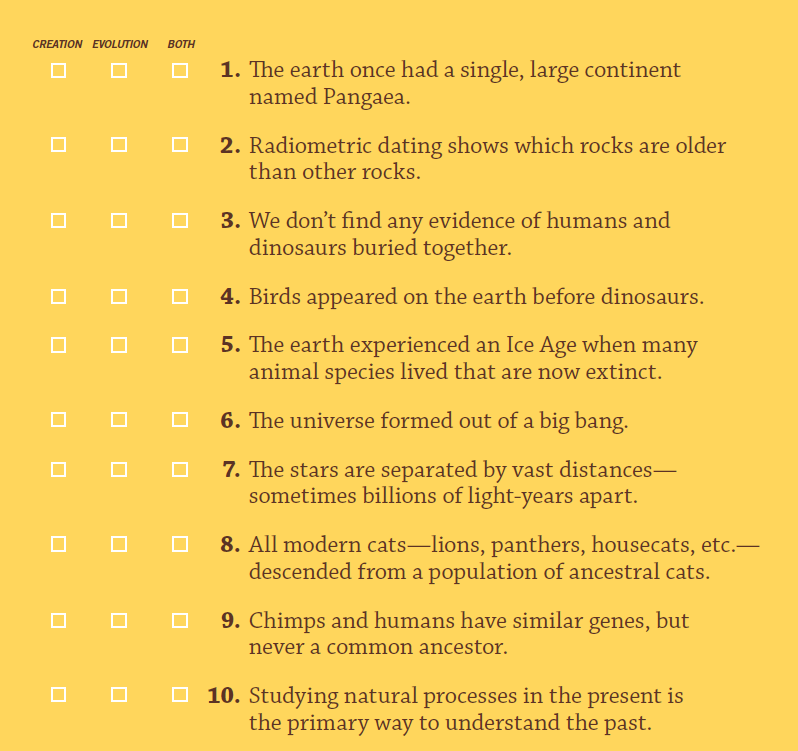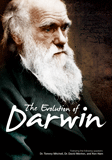
Surprising Similarities Between Creation & Evolution
One of the big dangers in sharing our faith is to get sidetracked. It helps to acknowledge areas of agreement before getting into the deeper issues that really matter.
I’m a certified creationist—a Bible-loving, six-day-believing, global-Flood-teaching creationist. I believe man was uniquely created in God’s image. All that stuff in the first 11 chapters of Genesis? Yep, I think of it as real, grade A history. Not only that, but I put my science where my faith is. Geology, biology, astronomy—they all line up with those lines of Hebrew.
Now, all that might not surprise you. Creation and believing the Bible go hand in hand after all. But get this. When I’m talking or listening to an evolutionist—even an atheist one—I can actually nod my head in agreement in many areas. No, I don’t mean about the weather or the sad state of my favorite sports team (come on, Cowboys). I mean about science.
Cue the scratched record sound.
Science? A creationist and an evolutionist agree on science? How could someone who believes that God made everything in six 24-hour days agree with someone who thinks that natural processes produced all we see over billions of years?
Actually, it’s not as surprising as you might think. When we look at the universe around us, there are a lot of amazing things to see and study. No matter what our starting point (God’s Word or human reasoning apart from God), the stuff we examine doesn’t change. Fossils are fossils, carbon atoms are carbon atoms, and stars are stars. Our belief about the age of the earth doesn’t change the raw facts.
That doesn’t mean we agree on how to properly understand those facts, but we’ll get to that a bit later. First, let’s take a closer look at some surprising areas of concord.
Creationists and Evolutionists Agree . . .
We Don’t Have All the Answers
Stop me if you’ve heard this one before. “Creationists can’t do real science because they start from the Bible and the Bible can’t change. Real science means that we have to follow the evidence where it leads. Science doesn’t rule out answers before we start.”
Um—no. That’s really not the case at all.
It is true that—as any Christian should—we believe the Bible is God’s perfect Word. It records the true history of the universe as revealed to us by the one who saw everything happen. (It helps that He’s the one who did the creating.) He can’t lie, He has perfect understanding, and He has plenty of power to keep His Word (the Bible) safe and sound until it gets to us. So, that makes us confident we’ve got the real scoop on how we came to be.
But there’s something you won’t find in the Bible: every detail about how the universe works. The Bible gets it right when it does talk about science, but science really isn’t the main focus—Jesus is. God tells us that He created and that He flooded the earth, but there are few, precious details about the how of it all. We’d love to have a detailed schematic of the Flood’s inner workings, for example, but it’s not there. Instead, we have something like an Instagram snapshot.
One thing’s for sure, though—that leaves us with some big, unanswered questions. What did the types of animals that God created during the first week look like? What did Noah’s Ark look like? How can distant starlight reach us in a universe that is only six thousand years old? And just like evolutionists, we also want to understand Higgs boson particles, to find a cure for Alzheimer’s, and to discover what secrets a bombardier beetle could teach us about delivering needle-less shots.
The Bible doesn’t turn off our brains. In fact, it really gets them going and leaves us with thousands of questions to explore.

Illustration by Ben Stafford
Creationists and Evolutionists Agree . . .
Apes and Humans Share a Lot
Evolutionists love the great apes. They point to them as our “closest living ancestor” because of all their similarities with us.
We like them too, and we agree to a part of their description. The great apes are “close” in the sense that they do share quite a few traits with good ol’ Homo sapiens. They have hands with five fingers, including an opposable thumb. Their basic body layout comes pretty close to ours. Their brains have the capacity to learn simple communication skills through sign language or other nonverbal methods. Even their DNA shares many parallels to the DNA in our cells.
So, yes, the similarities are interesting—but so are the differences. Really, chimps, gorillas, et al. show the handiwork of a handy Maker. But that creativity comes through precisely because of how different they are from us. They weren’t made to walk on two legs—but they can knuckle-walk and swing through trees with beautiful grace. Their five fingers would look silly attached to our hands, but they’re exactly what you’d want for hanging around on limbs. Those brains wouldn’t get them into Yale, but they do a bang-up job computing how to dig up termites. And that DNA gives them the characteristics they need to thrive in their special environments, but it doesn’t come close to what God has enabled humans to do, the only creatures made in His image.
Why are apes so similar to us? Perhaps they remind us that physical qualities aren’t what make us truly unique.
Why are the apes so similar to us? That’s a great question. Do you remember how I said we don’t have all the answers? Well, here’s a prime example. We have some ideas, but we don’t really know for certain all His purposes for the similarities. (All creatures are similar to us at some level, which makes it easier for us to live with them and oversee them as God’s stewards.) Perhaps they remind us that physical qualities aren’t what make us truly unique and most like the Creator.
Whatever the case, apes do have similarities to humans. Anyone can see that. But the differences—ah, the differences—that’s what makes us able to praise our wise God with beautiful songs, while gorillas only grunt.
Creationists and Evolutionists Agree . . .
There Is Order to the Fossil Record
Some illustrations play tricks on your eyes because they seem to be pictures of two things at once. Is it a duck or a rabbit? A young woman or an old woman? Both images pop out depending on where you focus.
It’s exactly the same thing with the order in the fossil record. How? Dig in with me here.
The fossil record consists of billions of remains from animals and plants that have turned to stone. They’re piled up all over the world in layer upon layer of mud, sand, and other sediments hardened to rock. What’s really interesting here is that there’s a general order to the fossils. At the bottom, you’ll find mostly single-celled microorganisms, then sea creatures in abundance, such as sponges, clams, and squids. Move up, and you’ll find amphibians, then dinosaurs, and finally birds and large mammals. (It’s a wee bit more complicated than that, but let’s just keep it simple.)
You could take a look at that stack of fossils and assume that those layers mean billions of years of creatures evolving from sea to land. But the fossil picture can take on a completely different look if you think of it another way—through the lens of Noah’s trip on the Ark.
The Bible implies that the earth was relatively stable before the Flood, so few things were fossilized, mostly microorganisms. The Flood brought dramatic change as the fountains of the great deep split wide open. The animals in the oceans were likely buried first. As the waters rose, creatures on land were buried next. Throw in the fact that animals live in varying environments (for example, plains and forests), and you can see that the fossil order isn’t about time, but about location, order of burial, and other aspects.
Also, fossilization requires special conditions. When most things die, scavengers and bacteria quickly do away with them. But we have billions (that’s with a b) of fossils all over the earth—a smorgasbord of all kinds of amazing creatures. Rapid burial of creatures during one global yearlong Flood explains why.
Creationists and Evolutionists Agree . . .
Earth Was One Big Continent
If you’ve ever looked at the eastern coast of South America on a map, you’ve probably noticed that it looks like a good fit with the west coast of Africa. They look like puzzle pieces that the obsessive-compulsive side of us wants to put back together.
You’re not imagining things. When we study the shape of the continents, we find several places that look like they should be joined. We also find similar types of fossilized plants and animals that lived on both sides before the land-masses were snapped apart. Seems pretty convincing, huh?
Well, you can even see where similar types of rock and sediment layers are on both sides of the divide. For example, the same sandstone beds run across most of North America, across northern Africa, and into Israel. That’s three continents, separated by an ocean and a huge sea!
Let’s just say that the evidence is pretty solid for the continents being a conjoined mass at one point. On this, evolutionists and most creationists agree.
But when and how—those two questions split us up. For evolutionists, the earth’s tectonic plates have been in motion possibly for several billion years, but definitely starting in earnest with the breakup of one large continent called Rodinia. (There are varying views here, but we’ll stick with the most common.) Since then, the plates have split apart and slammed together over and over again in a billion-year-long earth-works ballet.
For creationists, Genesis 1 spells out for us that God gathered all the oceans into one place and land in another at the start. Most infer from this that He made one giant landmass, but some do not agree on how and when it broke up. Go back and read about those fountains of the deep tearing open (Genesis 7:11, 8:2). This giant crack set in motion “runaway” movement of the continental pieces at breakneck speed. Under the floodwaters, plates pulled apart, slipped by each other, and rammed into each other, forming mountains. (Actually, you’d need speed like that to form huge mountains.) After the Flood and the rapid geological race wound down, the continental plates slowed to the crawl we see today.
What’s more, the Flood is a great way to explain why we see similar layers of sediment, such as sandstone, on a global scale. Many catastrophes on local scales over billions of years simply can’t spread a single sediment layer across several continents.

Illustration by Ben Stafford
Creationists and Evolutionists Agree . . .
Natural Selection Really Happens
Do you remember how I said that creationists and evolutionists agree on the raw facts, but not what those facts mean? Well, here’s one area where that comes into play—natural selection.
Wasn’t that Darwin’s magnum opus? If we agree to natural selection, don’t we have to agree to everything else he said, too? Not even close. You see, there are facts, and then there are interpretations of those facts. The interpretation part is where things can get sticky.
Animals change over time, but these genetic changes aren't the same as evolution. Natural selection works only on what’s already there.
When we study nature, evolutionists and creationists both agree that animals change over time. For example, some birds have thick beaks that make it easier for them to crack tough seeds. If soft seeds become scarce and hard seeds are coming out their ears (figuratively speaking), then birds with thicker beaks will have an easier time finding breakfast. So, they’re more likely to survive and have chicks. Thick-beaked birds “win” the buffet battle.
But that’s where we have to draw a line in the sand. Natural selection works only on what’s already there, what traits the birds already had. Different animals might have lips, mandibles, or beaks, but no amount of increasing or decreasing thickness of a beak could ever produce a lip or mandible. You can’t make something new out of material that isn’t there.
Natural selection can, over a few generations, help finches on the Galápagos Islands get to the best food (that’s where we agree), but it won’t work to turn a Velociraptor into a vulture, no matter how much time you throw in. When God made the first animals, He gave them enough information in their DNA to vary and shuffle around all sorts of characteristics—height, color, limb lengths, and more. That’s because He wanted them to “fill” the world with wonderful variety.
But these genetic changes aren’t the same as evolution. You can mix in all the genetic changes you want, and you still won’t get the types of wholesale changes that Darwin envisioned, from a single cell to soaring birds. Instead, you get finches that have finches that have finches. It’s really not a tough nut to crack.
Putting It All Together
The chasm between evolutionists and creationists isn’t what many people think it is. We both study the universe and agree on the basic nature of the data coming in. We can shake hands about the fundamental laws of how things work. We both love science.
We’re just starting from two very different places as we interpret its larger historical significance. That goes beyond our ability to observe facts and perform repeatable experiments. It depends on our untestable assumptions about the past, which nobody was present to observe.
Here’s the reason for concern. Evolutionists rely on a human-centered approach. They have no higher authority, no higher source of information, than the gray matter in their heads. They are unwilling to check their work against an answer key because they don’t believe there is one.
We need to depend on the one eternal absolute source of truth and understanding in the universe—our Creator.
I don’t know about you, but I can’t trust my fallible brain to remember where I left my bottle of water, let alone on matters of how we came to be. I recognize my limitations, and I believe that we are designed to recognize our limits and need to depend on the one eternal absolute source of truth and understanding in the universe—our Creator. In fact, I would humbly submit to you that a human-centered approach leaves a lot to be desired.
There is something much better. You see, God loved us enough to tell us exactly what He did and when He did it, at least in the most important matters of our origin, purpose, and destiny. He wanted us to know Him and to know that He would one day enter into His creation to save us from our sin (Philippians 2). If He’s an all-knowing, all-powerful, all-everything God who wants us to know Him, wouldn’t we be much better off trusting His revelation of history and the universe and everything?
Yeah, that’s why I’ll take His explanation every time.
Creation or Evolution?
Do You Know Where Creationists and Evolutionists Agree?

Quiz Answers
- BOTH. Evolutionists believe tectonic plates moved slowly over hundreds of millions of years to form supercontinents, beginning with Rodinia and later Pangaea. Many creation geologists, in contrast, believe God made a supercontinent (similar to Rodinia) only 6,000 years ago. This continent broke up at the start of the Flood; the fragments moved rapidly apart, briefly recombining to form Pangaea.
- BOTH. Evolutionists believe radiometric decay happens at a constant rate over billions of years, allowing them to assign absolute ages for certain rocks. Creation geologists accept radioactive decay, but not necessarily at a constant rate, especially during the Flood. This decay allows us to assign “relative dates,” but on a timescale of thousands of years.
- BOTH. Evolutionists believe dinosaurs went extinct nearly 65 million years before humans. Creationists, in contrast, believe God made humans and dinosaurs on the same day of creation. There are several ways to explain why their fossils are not together. For example, they may not have lived in the same area, so they weren’t buried together.
- CREATION. Evolutionists believe birds evolved from dinosaurs, but the Bible plainly teaches that God created the birds one day before the land animals, which includes dinosaurs.
- BOTH. Evolutionists believe the earth experienced several ice ages (the most recent one 2.6 million years ago), but they don’t have a good mechanism to explain it. Creationists, in contrast, believe that the Flood produced ideal conditions—warm oceans and cold, empty continents—to generate a single, brief Ice Age that lasted only centuries.
- EVOLUTION. Contrary to the big bang, Genesis 1 clearly says that God made the earth and oceans before He made the sun, moon, and stars.
- BOTH. Evolutionists believe distant starlight has been traveling for billions of years to reach the earth. Creationists, in contrast, believe Genesis 1, which says God created stars during Creation Week only 6,000 years ago. They are exploring various models to explain how starlight reached earth quickly.
- BOTH. Evolutionists believe all living things descended from a single-celled common ancestor over billions of years. Creationists, in contrast, believe that God created separate “kinds” of animals 6,000 years ago. Each had lots of potential for variation and adaptability, but within the limits of the overall kind. Cats always produce cats, never other kinds.
- CREATION. Evolutionists believe humans and apes shared a common ancestor, but the Bible says God made the first human, Adam, from the dust of the earth.
- EVOLUTION. Creationists believe that present processes help us to understand the past, but they also know from Scripture that God intervened in several unique events that had a profound impact on earth and will never be observed or repeated again (Creation, the Curse, the Flood, and Babel).

Do you know where creationists and evolutionists agree?
BOTH. Evolutionists believe tectonic plates moved slowly over hundreds of millions of years to form supercontinents, beginning with Rodinia and later Pangaea. Many creation geologists, in contrast, believe God made a supercontinent (similar to Rodinia) only 6,000 years ago. This continent broke up at the start of the Flood; the fragments moved rapidly apart, briefly recombining to form Pangaea.
-
The earth once had a single, large continent named Pangaea.
BOTH. Evolutionists believe radiometric decay happens at a constant rate over billions of years, allowing them to assign absolute ages for certain rocks. Creation geologists accept radioactive decay, but not necessarily at a constant rate, especially during the Flood. This decay allows us to assign “relative dates,” but on a timescale of thousands of years.
-
Radiometric dating shows which rocks are older than other rocks.
BOTH. Evolutionists believe dinosaurs went extinct nearly 65 million years before humans. Creationists, in contrast, believe God made humans and dinosaurs on the same day of creation. There are several ways to explain why their fossils are not together. For example, they may not have lived in the same area, so they weren’t buried together.
-
We don’t find any evidence of humans and dinosaurs buried together.
CREATION. Evolutionists believe birds evolved from dinosaurs, but the Bible plainly teaches that God created the birds one day before the landanimals, which includes dinosaurs.
-
Birds appeared on the earth before dinosaurs.
BOTH. Evolutionists believe the earth experienced several ice ages (the most recent one 2.6 million years ago), but they don’t have a good mechanism to explain it. Creationists, in contrast, believe that the Flood produced ideal conditions—warm oceans and cold, empty continents—to generate a single, brief Ice Age that lasted only centuries.
-
The earth experienced an Ice Age when many animal species lived that are now extinct.
EVOLUTION. Contrary to the big bang, Genesis 1 clearly says that God made the earth and oceans before He made the sun, moon, and stars.
-
The universe formed out of a big bang.
BOTH. Evolutionists believe distant starlight has been traveling for billions of years to reach the earth. Creationists, in contrast, believe Genesis 1, which says God created stars during Creation Week only 6,000 years ago. They are exploring various models to explain how starlight reached earth quickly.
-
The stars are separated by vast distances—sometimes billions of light-years apart.
BOTH. Evolutionists believe all living things descended from a single-celled common ancestor over billions of years. Creationists, in contrast, believe that God created separate “kinds” of animals 6,000 years ago. Each had lots of potential for variation and adaptability, but within the limits of the overall kind. Cats always produce cats, never other kinds.
-
All modern cats—lions, panthers, housecats, etc.—descended from a population of ancestral cats.
CREATION. Evolutionists believe humans and apes shared a common ancestor, but the Bible says God made the first human, Adam, from the dust of the earth.
-
Chimps and humans have similar genes, but never a common ancestor.
EVOLUTION. Creationists believe that present processes help us to understand the past, but they also know from Scripture that God intervened in several unique events that had a profound impact on earth and will never be observed or repeated again (Creation, the Curse, the Flood, and Babel).
-
Studying natural processes in the present is the primary way to understand the past.
Related Videos
Journey to the Galápagos Excerpt
Related Downloads
Excerpt from The Heavens and the Earth, Chapter 4
PDF DownloadAnswers Magazine
April–June 2016
How well do you know the views of modern creationists? Test your knowledge and then discover how Christians can effectively share the gospel with homosexuals.
Browse IssueRecommended Resources

Answers in Genesis is an apologetics ministry, dedicated to helping Christians defend their faith and proclaim the good news of Jesus Christ.
- Customer Service 800.778.3390
- Available Monday–Friday | 9 AM–5 PM ET
- © 2026 Answers in Genesis






